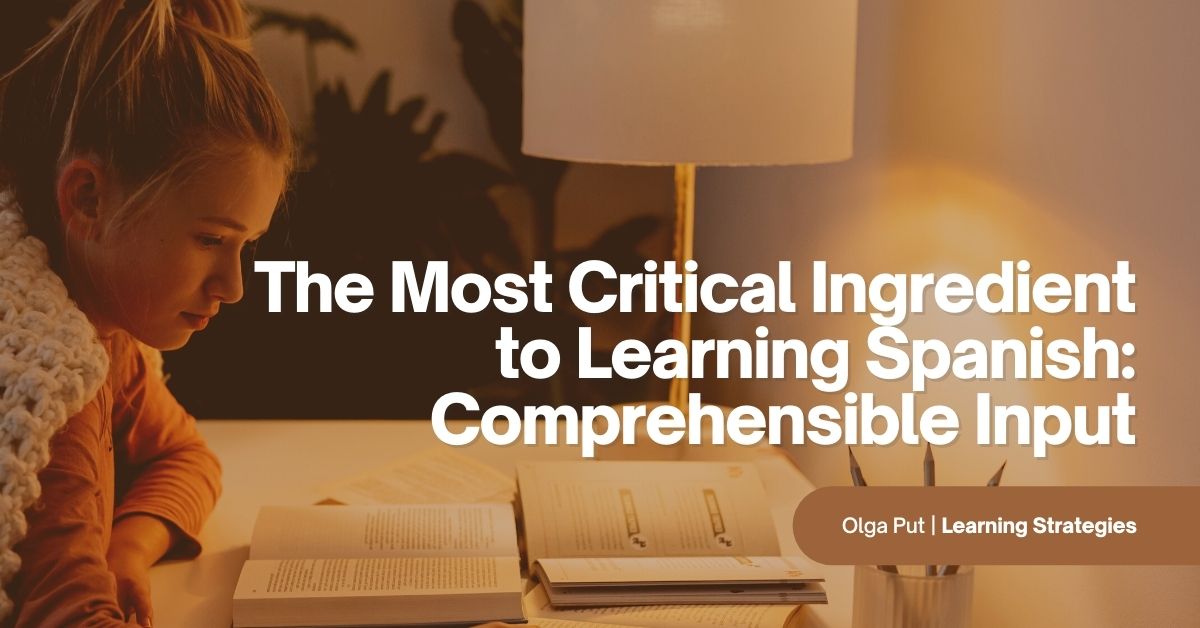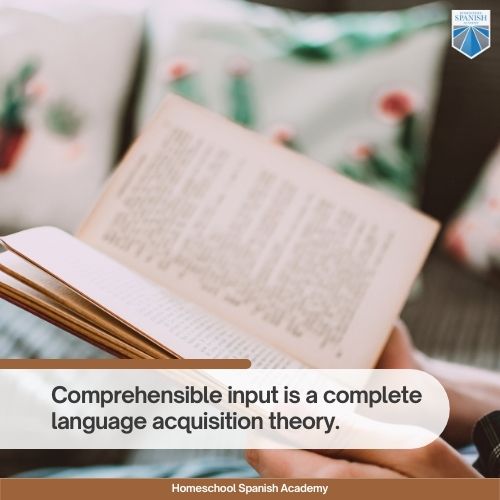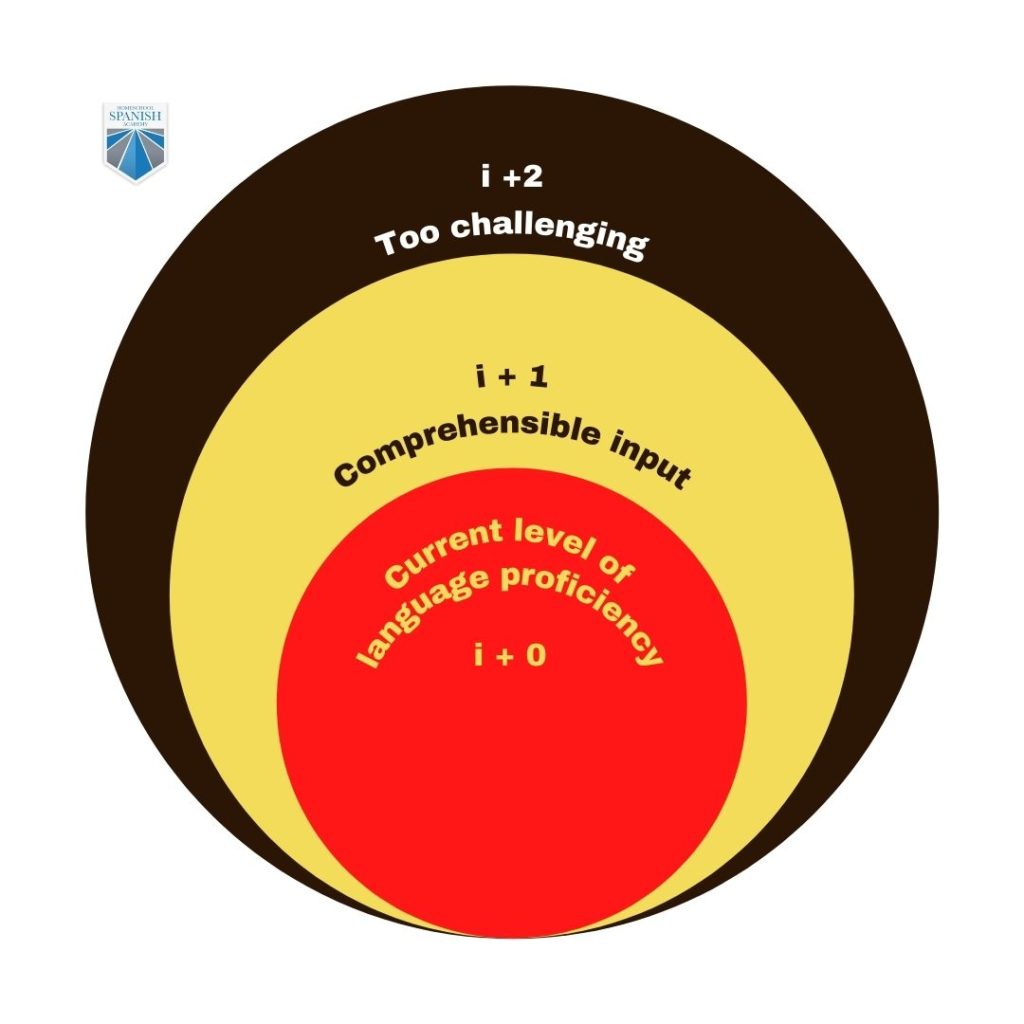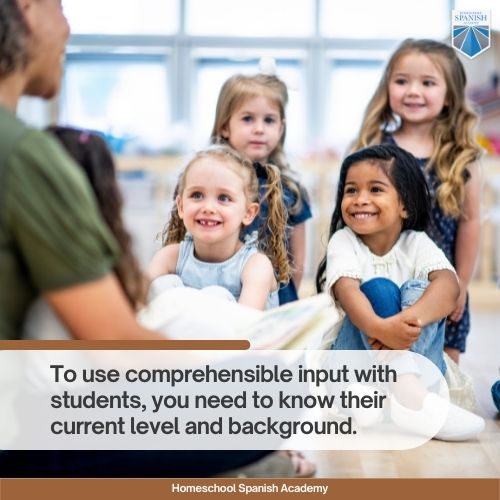
The Most Critical Ingredient to Learning Spanish: Comprehensible Input
Are you worried that your student or child are not advancing in language learning as quickly as they should? Do they seem to plateau for long periods at the same Spanish level?
If so, take a closer look at the teaching materials and techniques you use with them—and make sure to provide comprehensible input.
Have you heard about Stephen Krashen and his revolution in language teaching and learning strategies?
Not yet?
Get comfortable and keep reading!
I’ll tell you what comprehensible input is, how we use it at Homeschool Spanish Academy and how you can use it yourself.
What Is Comprehensible Input?
If you’re looking for a simple definition, comprehensible input is a complete language acquisition theory.
According to this theory, language students should study with materials they’re able to mostly understand that are slightly above their current level.
How can Homeschool Spanish Academy support your Spanish fluency?
Our K-12 programs are flexible, affordable, and fun. Learn more. ➡️

Stephen Krashen Theory
The author of this theory is Stephen Krashen, a US-based linguist and researcher. He is now about 80 years old and has been revolutionizing language teaching and learning for more than four decades.
Krashen based his theory on a simple formula that illustrates the input hypothesis:
i + 1
The letter “i” stands for input that refers to the current level of the student. The + 1 denotes that the language material should be taken from a level above the student’s current level.
Together, this means that the input is comprehensible yet challenging. Input focuses mostly on reading and listening materials.
What would happen if we used the i + 0 formula? No learning would occur.
And what would happen with i + 2 materials? The learning process would be too difficult and discouraging for the student.

The main point of Krashen’s theory is that if you give your students, for example, reading materials that are slightly above their language level, you’ll provoke natural learning strategies. The students will try to guess words from context and infer meaning.
But, how do you make your students read challenging texts and watch challenging videos? Well, that’s the secret. The materials must be compelling, interesting, and motivating for them.
Working with Krashen’s theory means that you need to know your students’ current level and interests.
According to Krashen, students learn in an almost subconscious and passive way, first through comprehensible and motivating input focused on extensive reading and listening.
Later, the teacher gradually introduces them to more complex language concepts. The learning occurs in a natural and predictable order in which students learn certain skills and language aspects before others.


Natural Learning Strategies and Examples
At Homeschool Spanish Academy, our certified teachers use comprehensible input theory on a daily basis. Let me tell you a bit about the strategies our teachers use with students.
1. Evaluating the Learner
To use comprehensible input with students, you need to know their current level and background.
HSA teachers take time to get to know their students. The initial evaluation happens during the first lessons, and our teachers keep track of their students’ progress. The evaluation means not only defining their language ability level, but also their interests.
Great Spanish teachers make sure the materials provided are understandable and at the same time challenging for their students.
2. Using Specific Language
Our teachers always use specific language that is understandable and appropriate. It makes the learning process easier and prevents confusion. HSA teachers provide lots of specific examples to help their students tackle difficult grammar concepts.
At the beginner level, our teachers know when to slow down. They speak clearly and in short sentences.
3. Using Varied Multimodal Resources
Students learn in different ways. That’s why, at HSA, our teachers explain the same concepts in different ways and use different resources to make sure the students understand the essential aspects of the language and acquire new vocabulary.
You may, for example, read a dialogue between a doctor and a patient and watch a scene from a video that uses the same vocabulary. You’ll practice repeating questions and answers and learning what they mean.
Visual cues are especially important to make sure our students understand what is being taught and have enough context.
How can you read a text about, let’s say Guatemala, if you can’t imagine its beauty? Our teachers always accompany the texts with pictures and videos.
Hand-picked for you: How To Use Visual Aids for Spanish Learning

4. Teachers Who Are Native Speakers
Having the opportunity to hear the target language used by native speakers is important. During HSA classes, the students not only work on authentic materials, but also study with teachers who are from Guatemala and live there.
Conversations with native speakers assure that you’re learning the most current version of the language, the language that people speak in everyday conversation. It also helps you get used to native speaker intonation, melody, and speed.
See also: 10 Reasons to Learn Language With Native Speakers
How To Implement Comprehensible Input on Your Own
Use Krashen’s theory with your child or students during Spanish classes. Let me show you some easy examples of comprehensible input in Spanish that you can implement in your classes:
1. Provide Lots of Input
Make sure the students spend most of the learning time listening and reading authentic language. Of course, the input must be level-appropriate and about 80% comprehensible.
Work with authentic materials that are adequate for the relevant levels and ages.
Check out:
- Spanish People Talking: 10 of the Best Listening Resources for Beginners
- Spanish Lessons for Adults: 10 High-Quality Resources
- 25+ Resources to Promote Spanish Listening Practice for Kids

2. Let Students Choose Their Areas of Interest
Ask what books they like and what movies or series they watch. Choose language materials that are related.
Recommended reading:
- Top 10 Most Remarkable Latin American Authors of All Time
- 12 Hispanic Authors Who Target Young Adults and Teens
- 10 Spanish Language Movies Available to Watch on Netflix US
- 8 Popular Spanish Sitcoms That Can Make You Fluent (And Funny)
- 10 Spanish Reality TV Shows on Netflix That Beat All the Rest
- 10 Must-See Spanish Shows on Hulu
Our certified, native Spanish-speaking teachers build conversations around your interests!
Learn more about what to expect from your free trial class. ➡️
3. Try Shadowing
The students should repeat the phrases they hear, for example, in a movie trying to imitate the pronunciation and intonation.
If your students love Encanto, choose the most iconic lines from this film and make them act them out.
Higher-level students can memorize parts of famous speeches or act out dialogues to try other forms of speaking activities.
4. Learning More About the Theoretical Background
To learn more about Comprehensible Input and Krashen’s language theory, download the following resources from Stephen Krashen’s website:
- Second Language Acquisition and Second Language Learning
- Principles and Practice in Second Language Acquisition
- The Natural Approach. Language Acquisition in the Classroom
Take a look at the resources at our site that help you with homeschooling and teaching:
- The Parent’s Ultimate Guide to Start Homeschooling Today
- How to Create a Homeschooling Routine (and Include Learning Spanish!)
- The Brilliant Way to Homeschool Your Preschool (Pre-K) Child, Ages 2-5
- Which Pre-Teaching Strategies Work Best for Students Learning Spanish?
- 21 Spanish Teacher Blogs To Enhance Your Lessons
- 10 Characteristics of the Perfect Spanish Teacher
Do You Need Support at Home or In Your Classroom?
Being bilingual is the key to a better and easier future for your child and students. Children who are able to communicate with people from other cultures not only obtain more professional opportunities, but will also be more open to diversity, whether cultural, social, or linguistic, than their monolingual peers.
Do you feel like implementing comprehensible input with your child or students but don’t feel capable of doing it yourself?
Homeschool Spanish Academy (HSA) provides 1-to-1 or 2-to-1 Spanish classes for kids, teenagers, and adults who wish to learn Spanish in a swift and efficient manner. Our teachers are prepared to help homeschool kids achieve their language goals and support regular K-12 students.
HSA offers flexible scheduling, affordable pricing, and tailored Spanish programs that can fit your lifestyle. Sign your child up for a free trial class to give us a try today!

Join one of the 40,000 classes that we teach each month and you can experience results like these

“HSA offers very affordable, quality, one on one classes with a native speaker. My son has greatly benefited from taking classes. We have seen his confidence increase as well as his pronunciation improve, because he learns from a native Spanish speaker. HSA has quick, personal customer service. Our family has been very pleased with our experience so far!”
– Erica P. Parent of 1

“HSA offers very affordable, quality, one-on-one classes with a native speaker. My son has greatly benefited from taking classes. We have seen his confidence increase as well as his pronunciation improve, because he learns from a native Spanish speaker. HSA has quick, personal customer service. I have appreciated the one on one interaction and teaching that my son gets from his teachers. He has gotten to know his teachers, which has increased his confidence in speaking Spanish. Our family has been very pleased with our experience so far!”
– Maple, Parent of 3

“I love that my children have the opportunity to speak with a live person. They get to practice Spanish in a 1-1 setting while improving their speaking, writing and reading skills during their lessons. HSA is a great way to learn Spanish for all ages! My children are 6, 9 and 11. My oldest two (9 and 11) have been taking classes with HSA for almost 2 years now. They love seeing their teacher each week. They understand the importance of learning several languages. I’ve seen them grow and learn with HSA. I’m excited to see how they will improve the more classes they take. I highly recommend them. You can’t bet learning and speaking with a live teacher. I’ve tried other programs. It’s just not as motivating.”
– Karie Ann, Parent of 3
For You—Free Spanish lessons and materials:
- World Mental Health Day: A Vocabulary Guide for Mental Health Workers
- Words and Phrases Related to Transportation in Spanish Part 2
- Hiking in Spanish: A Vocabulary and Conversation Guide
- How to ask for help in Spanish: A Conversation Guide
- The Spanish Airport Vocabulary Guide You Need
- Llegar vs Llevar in Spanish: What’s the Difference?
- Ordinal Numbers in Spanish
- Say ‘By the Way’ in Spanish (and Other Useful Idioms for Conversation)
- 10 Homeschooling Styles You Need to Explore in 2023 - March 14, 2024
- Home Sweet Classroom: Creating Engaging Spanish Lessons at Home - October 13, 2023
- Expressing Appreciation in Spanish on World Teachers’ Day - October 5, 2023





